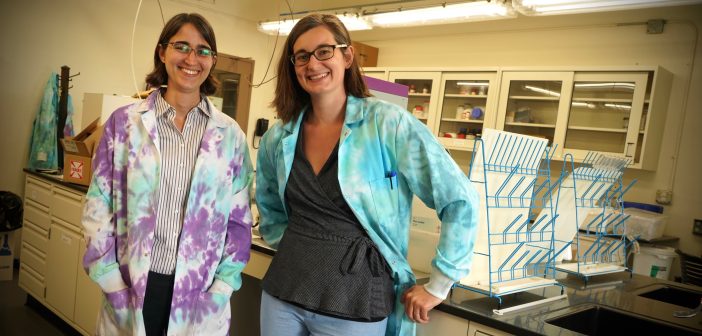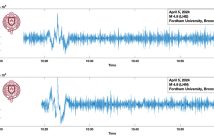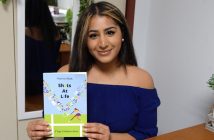Chemistry Department Chair Ipsita Banerjee, Ph.D., said the addition of these two scientists will expand not only the department’s ability to provide specialized research opportunities to students, but also the scientific community’s knowledge of important areas like solar energy and genetic diseases.
“Dr. Schneider’s field of research is in the area of design and synthesis of novel organic semiconductors for building devices such as solar cells,” said Banerjee. “Dr. Thrall’s research may further advance our understanding of the mechanistic processes involved in diseases like cancer and provide more information about how a lack of proper DNA repair mechanisms are involved in genetic disorders.”
In time, these are things that Fordham undergraduates will learn, too.
“The types of research that we’re doing—the techniques we’re using and the problems we’re investigating—are really cutting edge. These are things that are getting done at top graduate schools across the country,” said Thrall, a two-time Ivy League graduate. “These are approaches that [our] undergraduates can learn.”
A Long Line of Chemists
Thrall is an assistant professor of chemistry who started teaching at the Rose Hill campus this September. A Philadelphia native, she comes from a family of chemists. Her grandparents, especially her grandmother Jean Simmons who earned a Ph.D. in chemistry from the University of Chicago in the late 1930s and taught at women’s colleges, inspired her to become a chemist. Her other inspiration was the science itself.
“Not to sound cheesy, but chemistry is the central science; it extends into biology and physics,” she said. “I’ve always enjoyed the breadth of topics you can explore as a chemist.”
Her lab at Fordham specializes in single-molecule biophysics: a field that explores how biological systems function by analyzing the behavior of biological molecules, one at a time. The goal is to understand how DNA replication and repair work.
“It’s remarkable that we can look inside a living bacterial cell and see a single molecule moving around. If you watch the movies that we record in my lab, you’ll see a single spot of light bouncing around rapidly in this small cell. That’s a single protein in the cell,” said Thrall, who has published work in several publications, including Nature Communications.
Thrall served as a National Institutes of Health National Research Service Award postdoctoral research fellow at Harvard Medical School for six years. She earned a bachelor’s degree in chemistry and physics from Harvard University and a Ph.D. in chemical physics from Columbia University.
This semester, she is teaching a physical chemistry lab for juniors and seniors; next spring, she plans on teaching a lab course and a physical chemistry lecture. Two undergraduate student researchers recently joined her lab.
A Pastry Chef Turned Chemist
Schneider is an assistant professor of chemistry who joined the Fordham faculty last fall. She was born in Paris, France, to a French mother and an American father. What drew her to chemistry was the ability to create something new—something that no one has seen before.
“Every new molecule, every new structure can have new properties,” Schneider said. “There’s a ton to discover.”
She said chemistry reminds her of her days as a pastry chef in Boston, where she concocted chocolate lava cakes, handcrafted ice cream, and Boston cream pies on a daily basis.
“It’s nice making something, and then someone eats it at the end of the day. You served a purpose,” she said. “[Similarly,] I love organic chemistry because you get to make something.”
She earned a bachelor’s degree in chemistry from Southern Connecticut State University and a Ph.D. in chemistry from McGill University, where she was a Vanier Scholar. From 2016 to 2018, she served as a postdoctoral researcher at the University of California, Santa Barbara, where she collaborated with visiting researchers as part of the Mitsubishi Chemical Center for Advanced Materials.
At Fordham, she teaches organic chemistry I and II labs to sophomore students, who learn how to identify, purify, and separate different compounds. Last summer, she mentored her first three undergraduates through University research grants. They began by setting up her new research lab and then started on the synthesis of a new organic semiconductor. This fall, Schneider and those three students—her new lab mentees—will continue to tackle that project.
Schneider’s lab specializes in organic electronics. She has extensive experience in solar cells and transistors, but she now works on illuminating the structure-property relationships that drive these devices.
“Through organic synthesis techniques, we can make materials with any properties we want. So if we want something to make a solar cell, we can design it to absorb light and give us electrons. If we want something to emit light, like an OLED [organic light-emitting diode]on your phone, we can design a molecule that makes that color,” she explained.
Not all the materials may work, but they will teach us more about the behavior of organic semiconductors.
“As we discover new properties, maybe that particular molecule won’t be super useful right away,” said Schneider, “but who knows what application it may have in the future.”



